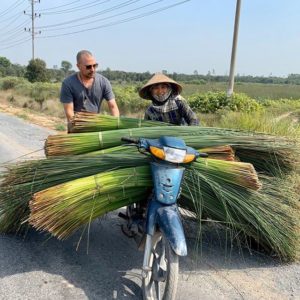A startup seeks to replace plastic straws with a type of grass
 17 Maret 2020
17 Maret 2020
Plastic straws are among the most pernicious disposable plastic items. They are used once and then discarded without a second thought. And not just a few either but billions upon billions of them.
Worse yet: they are nonessential items as you don’t really need to use one to drink from a glass or bottle with ease, although they are sure convenient.
Yet that convenience comes at a cost. Most plastic straws are made of polypropylene, which isn’t easy to recycle. That means that billions of straws end up in the environment, including the oceans.
“[T]he negative environmental impact of plastic straws is disproportionate compared to volume,” an environmentalist site notes. “Every year we go through a staggering 25.3 billion plastic straws in Europe. In the US it is said that we use 500 million plastic straws a day.”
Several businesses have been phasing out their use. Others are seeking to replace plastic straws with ecofriendly alternatives. One such initiative is a Vietnam-based startup behind Strawlific, a brand that manufactures drinking straws from natural grey sedge.
“Our straws are grown in the tropical wetlands of Vietnam, are handpicked by local farmers, and cut, cleaned, sterilized and packaged in our headquarters,” it explains. “Grey sedge and tropical reed are natural plants long used by rural farmers and grow alongside agriculturally cultivated areas.”
Sustainability Times has spoken to Hungarian environmentalist-entrepreneur David Simon, who once worked for the United Nations and now runs Strawlific with his business partners in Ho Chi Minh City, also known as Saigon.
Sustainability Times: What made you decide to start a venture aimed at manufacturing sustainable straws?

David Simon: The moment I came across these natural straws I knew I wanted to put it on my agenda. After meticulous market research we officially launched this project in Saigon. It was quite obvious to me that this is one of the best solutions when it comes to straws.
We use around 2 billion or even more straws per day on a global scale and the numbers are growing. Our habit of using straws is very likely to continue. By giving people a green alternative we hope to reduce the number of plastic straws.
Can you tell us about the manufacturing process?
The beauty of this product is that it has a much lower ecological footprint than other alternatives to plastic. The raw material is a plant called grey sedge, which is a type of tall grass native to the marshlands of subtropical climates. What the locals call “yellow sedge,” the fully grown taller and sturdier type, has the best attributes to serve as straws in particular.
They are grown and cultivated in the vicinity of Saigon where large sedge swamps are located. These fields provide us with a sufficient daily supply. The thousands of farming families who have been cultivating these plants from time immemorial know how to sustain, plant, harvest and replant sedge, which has been used to make mats, bags and several other items for centuries.
The essential part of the straw-making process is how the plants are cleaned and dried. There are several tiny details to be taken into consideration. We have mastered this process, we believe, creating arguably the best natural straws in the world. An important thing is to maintain quality even as quantity increases.
We employ locals in the production process, which creates job opportunities for rural people. By keeping automation to a minimum for the time being, we have set a needed sustainable pace for our current environment. Our energy needs are mainly covered by renewable sources such as solar energy and we look forward to the day when we can completely step away from fossil fuels.
What are the main advantages of these natural straws?
Our product has a guaranteed shelf life of 12-15 months, which leaves plenty of time for use and reuse before they need to be disposed of. Even when they are disposed of, they are fully biodegradable and even beneficial to the environment because the plant matter enriches the soil as it decomposes easily.
Admittedly, natural straws cost more than cheap plastic straws, but I feel it is ironic when we complain about having to spend two cents for a straw when we are happy to spend $5 or $10 on a drink. Even paper, PLA or any other substitutes for plastic straws can have large hidden ecological and environmental costs in the long run. Paper straws are unreasonably becoming popular simply because they are cheap enough. Yet drinks tend to taste terrible when sipped through paper straws.
What are the considerations involving hygiene and durability?
Excellent hygiene standards are a must for us. The main thing that sets us apart from similar ventures in Vietnam is that our products go under a special UV disinfection line. Selection and a second disinfection process take place at a separate facility in Ho Chi Minh City before the straws are packaged. The first disinfection is the drying process itself, which is done in heated ovens. Because these products come in direct contact with people’s mouths, hygiene cannot take a backseat.

How important do you think small green enterprises like yours are when it comes to making a difference?
Our motto is “The change starts with You” and I think that answers the question. Real paradigm shifts always start on a small scale and and go from there thanks to perseverance and determination. The clock on climate change and environmental destruction is ticking faster than ever. We need to slow down the current insane pace of rampant consumerism and embrace sustainable solutions.
How aware do you think most people are of the curse of plastic pollution in countries in Southeast Asia, such as Vietnam, that are the main drivers of such pollution?
Awareness is growing at a great pace, which is highly encouraging. A good friend of mine who has been regional sales manager in the plastic industry can reel off a long list of data and references on how little we know about the facts. He schooled me on this the last time we met.
First of all, we strictly have to differentiate between single-use and multiple use plastic items. For instance, our straws offer an alternative to replace single-use plastic items. However, single-use plastic is just a smaller part of the plastic industry and multiple-use/long-use plastics are in many ways the best solutions we have come up with.
The post A startup seeks to replace plastic straws with a type of grass appeared first on Sustainability Times.
